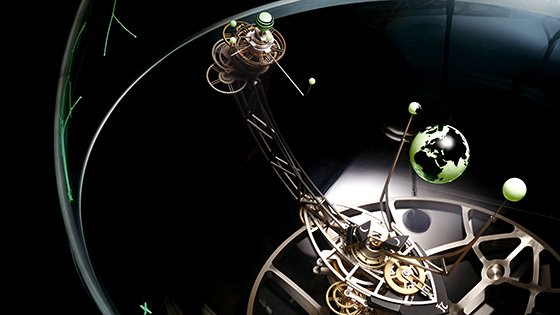
Through the eyes of Galileo Galilei and the watchmaking expertise of Panerai, the intriguing and astronomical world of Jupiterium unfolds. This planetarium clock of advanced mechanical complexity pays homage to the genius of the Italian physicist whose revolutionary scientific spirit reflects the Maison’s own mission. Showcased at Watches and Wonders 2025, this large-scale installation, measuring 75cm in width and 86cm in height and weighing around 110kg, replicates the fascinating movements of cosmic entities known to mankind thanks to the findings of Galileo.
In 1610, Galileo’s observations provided critical evidence that Earth is not the centre of the universe, challenging the long-held geocentric model. With his telescope, he observed four satellites orbiting Jupiter and now known as the Galilean moons: Io, Europa, Ganymede and Callisto. Inspired by this, the Jupiterium sets out to re-create the astronomer’s geocentric perspective of the heavens.
With Earth placed at the centre of the celestial sphere with other heavenly bodies rotating around it, the clock displays the positions of the Sun, Moon and Jupiter, as well as its four Medicean stars. These orbits are guided by a manual-winding mechanism with a single-line display perpetual calendar that drives the real-time movement of the celestial bodies. The mechanism contains eight barrels, each equipped with a four-metre-long spring and thus adding up to a total 32 metres. These lengthy springs are integral to the clock’s 40-day power reserve system, providing the energy for sustained operation and the smooth functioning of its intricate mechanics.
The movement requires no adjustments until the year 2099 and accurately displays the day, date, month and year, automatically adjusting to account for varying month lengths and leap years. Programmed to operate until the year 9999, at the end of each century Jupiterium will require only a watchmaker’s intervention to disassemble the movement bridge and rotate the hundreds disc by 90°, thus allowing the watch to continue counting off the years.
The sphere comprises the two Northern and Southern hemispheres, connected by a band symbolising the Earth’s equator and engraved with the 12 zodiac signs. The celestial sphere completes one full rotation every 23 hours, 56 minutes and 4 seconds – a sidereal day. In the Panerai Jupiterium, Italy is positioned prominently on the Earth model within the central blue sphere. When viewed from the front, Italy is aligned so that it faces directly outward, allowing observers to see the country clearly from a terrestrial viewpoint. This alignment is represents both Galileo’s perspective and Panerai’s Italian heritage, honouring the influence of his discoveries on astronomy and science.
The retrograde function in the Panerai Jupiterium is a particularly rare horological feature that represents the apparent “backward” motion of planets as seen from Earth. This phenomenon, known as retrogradation, occurs when a planet appears to move in reverse against the backdrop of stars due to the relative positions and motions of Earth and the planet in their respective orbits. To simulate this retrograde motion, particularly for Jupiter and its moons, Panerai has developed a patented mechanism that creates a visually accurate portrayal of how Jupiter appears to slow down, reverse and then resume forward motion in the sky over certain periods, a motion due to Earth overtaking Jupiter in its orbit. This effect is achieved through a complex system of gears and counterweights that control the positions and movement of the celestial bodies. This patented system of high-level precision allows the Jupiterium to display a faithful representation of retrograde motion, adding both technical sophistication and astronomical realism to the timepiece.
The celestial vault, complete with constellations, rotates to capture the visible movement of the stars as observed from Earth. The 1,650 intricately crafted components are primarily made from titanium, chosen for its lightweight yet durable qualities, which help manage the overall weight and strengthen the complex mechanism.
Encased within a glass box on a mahogany base measuring 75x86cm and weighing around 110kg, its dial is located beneath the main celestial display sphere. Set against a black base, the dial features long baton-type hour-markers and large, luminescent Arabic numerals at the 12 and 6 o’clock positions, ensuring readability even in low light. The hours, minutes and seconds hands are similarly coated with Super-LumiNova, enhancing visibility in the dark. Key indicators include an AM/PM marker and a linear power-reserve gauge bearing the inscription “40 giorni” (40 days). The flange is engraved with “Jupiterium” while the movement’s nature is also indicated in Italian (Calendario Perpetuo), with the day, date, month, and year arranged in a linear display.
May 22, 2025


 News
News